The Temples of King Dinh and King Le are located in the area commonly known as the Ancient Capital of Hoa Lu, in Hoa Lu district, Ninh Binh province. When visiting this place, tourists have the opportunity to delve into the historical values of the Vietnamese feudal dynasties during the 10th century. Witnessing the ups and downs of history, this is the only place in Vietnam where you can worship King Dinh, his parents, his sons, and the merits of famous generals. Explore the most special aspects of this historically rich land with DanangPrivateCar.com’s!
Table of Contents
The Temples of Kings Dinh and Le – Where are they located?
Situated on a spacious 5-hectare area within the specially protected zone of the national-level cultural-historical relic complex of the ancient capital Hoa Lu, it is located in Truong Yen commune, Hoa Lu district, Ninh Binh province. Over more than 1000 years of history, the ancient capital Hoa Lu has preserved historical relics from three dynasties: Dinh, Early Le, and Ly. Among them, the temples dedicated to King Dinh and King Le stand out as culturally and historically significant structures that hold great meaning for future generations.

The temple dedicated to King Dinh Tien Hoang, located in Yen Thuong village, Truong Yen commune, is situated on a spacious area covering nearly 5 hectares, with the Mã Yên mountain as a backdrop, and the temple facing east. The tomb of King Dinh Tien Hoang is located on the summit of Mã Yên Sơn – the reason being that the tomb of King Dinh is placed in the middle of the Mã Yên mountain, resembling a saddle, symbolizing the mission of repelling invaders and safeguarding the nation.
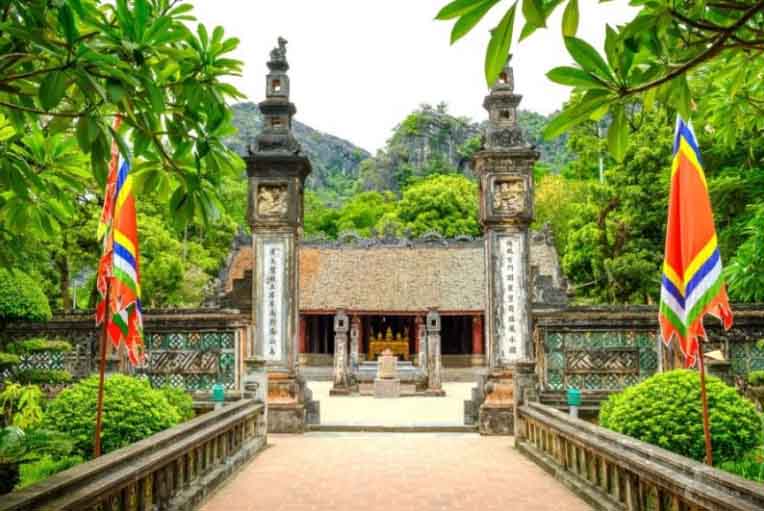
According to legend, the temples of King Dinh and King Le were built on the foundation of an ancient palace. According to tradition, when the Ly dynasty left Hoa Lu for the land of Thang Long (present-day Hanoi), the people built two temples to commemorate two national heroes, Định Bộ Lĩnh and Lê Hoàn. Initially, the temples faced north, overlooking the Ho and Che mountains. Over the years, the two temples no longer existed. In the early 17th century, after abandoning the Mac dynasty for the Le dynasty (1600), the regional lord Bui Thoi Trung rebuilt the two temples as before, but this time facing east, as recorded on a stele in 1606. In 1898, Mr. Ba Kenh, also known as Duong Duc Vinh, along with the people of Truong Yen Thuong, repaired the temple of King Dinh, constructed stone door thresholds, and elevated the temple on a stone platform, as it stands today.
Means of transportation to the Temples of King Dinh and King Le
Most domestic and international tourists typically fly to Hanoi before heading to Ninh Binh. Upon arriving at Noi Bai International Airport, travelers can proceed to Ninh Binh by booking a limousine or renting a private car. The travel time for the 100 km journey is approximately 2 hours.
If you are already in Hanoi, you have three options:
- Train: Ticket prices range from 90,000 to 200,000 VND depending on the train class and seat type. There are morning trains at 6:30 AM and evening trains at 7:20 PM. You will arrive at Ninh Binh Station and then independently take a taxi/motorbike/motorbike taxi to Hoa Lu Ancient Capital.
- Bus: The ticket price is only around 80,000 VND. The travel time is about 2.5 hours, including rest stops. Buses depart from Giap Bat Bus Station daily, and there are many direct buses to Ninh Binh, making it convenient to reach your destination.
- Motorbike: If you choose to go by bus, you will take the new National Highway 1A. However, if you travel by motorbike, you will follow the old route, passing through Thuong Tin, then visiting Phu Ly City, Ha Nam Province. Just follow Google Maps, and you will reach the luxurious and sparkling city of Ninh Binh. After an additional 7 km, you will arrive at the Temples of King Dinh and King Le.
- Private Tourist Car: With the private car service in Hanoi from DanangPrivateCar.com, you can quickly reach Ninh Binh. The door-to-door service, professional drivers, and basic English language assistance will make your trip more comfortable. Book your journey from Hanoi to Ninh Binh today for the fastest way to reach the Temples of King Dinh and King Le.
- Limousine: There are now many limousine companies operating the Ninh Binh route with the highest quality, offering pick-up and drop-off services at your doorstep for prices ranging from 250,000 to 350,000 VND per ticket. Therefore, do not hesitate to book a seat for a convenient and enjoyable journey to Ninh Binh.
The suitable time to visit the temples of King Dinh and King Le
The ideal time to visit the temples of King Dinh and King Le is during the annual festival dedicated to King Dinh. This festival takes place every year from the 8th to the 10th day of the third lunar month. During this three-day celebration, which typically falls around March 8th, visitors from various regions flock to explore and pay homage to the temples. This period also coincides with mild and pleasant weather, characterized by gentle sunlight and relatively cool temperatures, making it suitable for sightseeing. Additionally, you can consider combining your visit with the Bai Dinh Pagoda festival.
What is special about the Temple of King Dinh Tien Hoang?
The history of the formation of the Temple of King Dinh Tien Hoang
The Temple of King Dinh, constructed in the 17th century, is part of the historical complex of the ancient capital Hoa Lu and is ranked among the Top 100 famous 100-year-old structures in Vietnam.
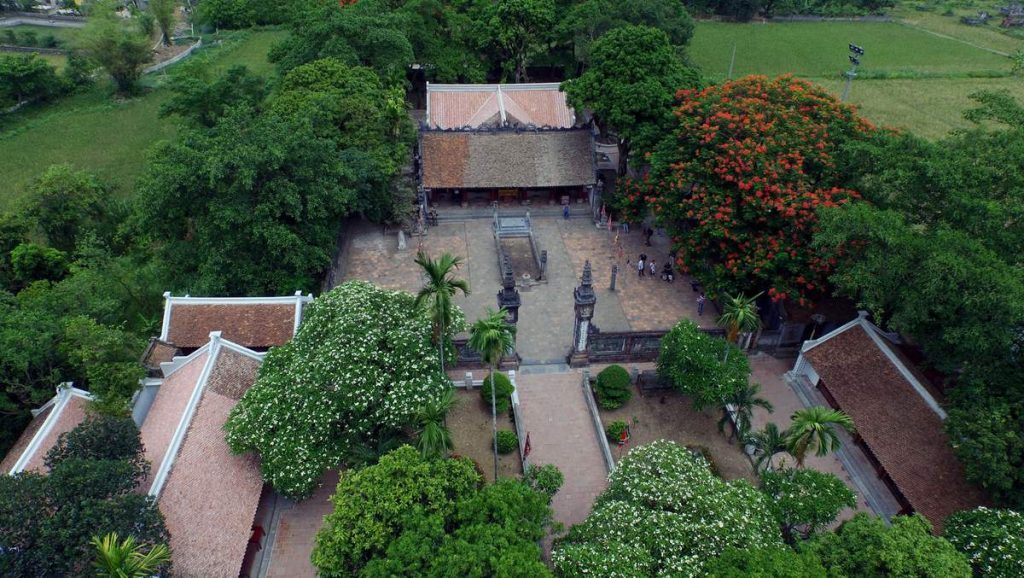
According to ancient legends, King Dinh and his son Dinh Lien were assassinated by Do Thich in the year 979. Following the court ceremony, a shrine was established with the royal title, personal name, and a temple built to worship them at their hometown. Therefore, the Temple of King Dinh was established from ancient times. Today, the remaining part of the temple reflects the architectural style of the Nguyen Dynasty. In his homeland, there are still many landmarks and legends associated with the childhood of the king as well as Nguyen Bac, Dinh Dien, and other renowned generals from Dai Huu, the same region as King Dinh Tien Hoang.
The Temple of King Dinh Tien Hoang – Unique architectural and artistic features
The Temple of King Dinh Tien Hoang features unique architectural and artistic elements. It is constructed in the style of “nội công ngoại quốc” (an architectural style with two long corridors connecting the front ancestral house with the rear worship house). The temple forms a rectangular frame surrounding the ancestral house, upper shrine, and other architectural structures in the middle. The inner part of the temple is designed in the shape of the character “工,” while the outer part forms a frame around it like the character “口” in the word “Quốc” (國).
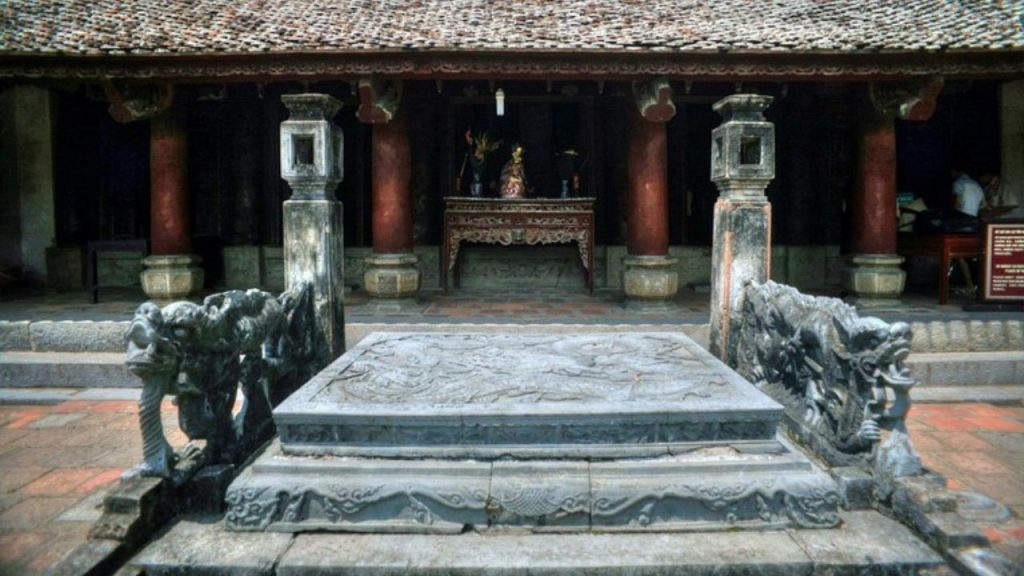
The Temple of King Dinh is built in a “đăng đối” style along the divine axis, starting from the crescent-shaped lake and ending at the Main Hall. As you enter from the outside, you’ll encounter the outer gate called Ngọ Môn Quan, where four Chinese characters “Bắc môn tỏa thược được” are inscribed on the gate’s background. Passing through the gate and looking back, you’ll see another four Chinese characters “Tiền Triều Phượng Các.” In front of the temple is the Crescent Lake, constructed in the architectural style of ancient palaces and adorned with beautiful lotus flowers.

The area for worshipping King Dinh Tien Hoang consists of three main halls: Bái Đường (Worship Hall), Thiêu Hương (Incense Offering Hall), and Chính Cung (Main Palace). In front of the central area of Bái Đường, on the dragon yard, stands a stone slab made of whole blue stones combined with exquisite carvings, showcasing remarkable floral patterns and artistic value. This is considered a valuable gift left by the dignitaries of the Dinh era, demonstrating their talent and artistic mastery. Moving from Bái Đường, you will encounter Thiêu Hương, followed by Chính Cung, consisting of five chambers, with the central chamber dedicated to the statue of King Dinh Tien Hoang. The statue is meticulously adorned in gold leaf, wearing the Bình Thiên hat, sitting on a stone slab with a dignified posture. Adjacent to it are statues commemorating the king’s offspring.
Explore the unique features of the Temple of King Le Dai Hanh
Situated not far from the Temple of King Dinh Tien Hoang, approximately 300 meters away, is the Temple of King Le – a place dedicated to King Le Dai Hanh. Located in the area of Truong Yen Ha village, Truong Yen commune, it is also known as the Lower Temple. The temple was built on the foundation of the ancient Hoa Lu palace, facing east and with Mount Den as the backdrop, while Mount Dia is situated behind.
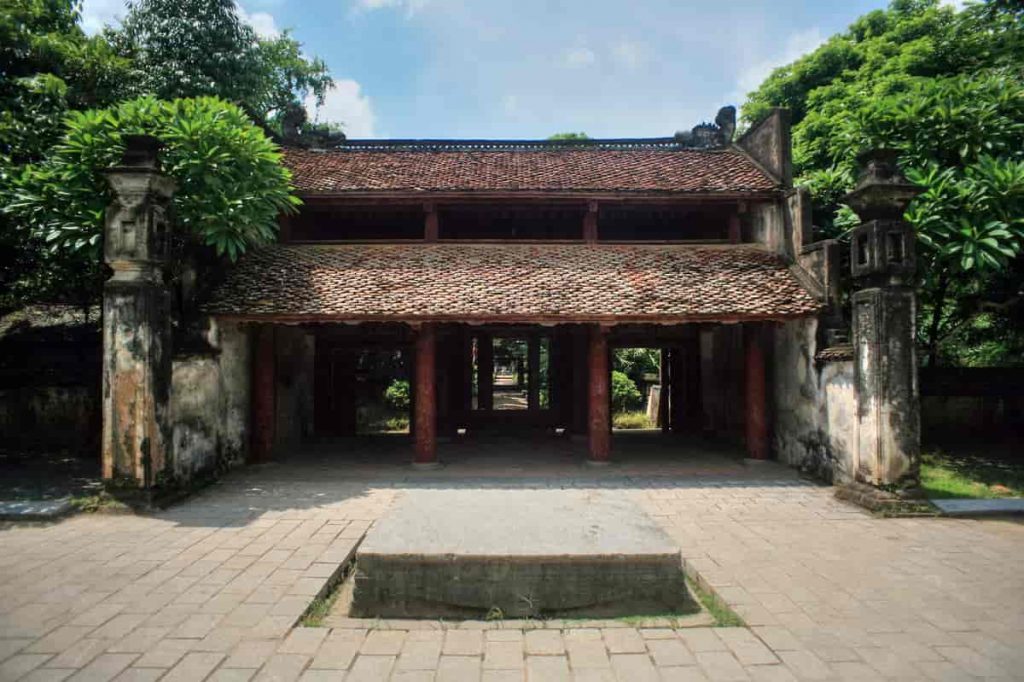
Although the Temple of King Le may not be as grand as the Temple of King Dinh because it has undergone fewer renovations, it has preserved many carvings from the later Le dynasty, making it more intricate than the Temple of King Dinh. The stacked bed carvings in the worship hall are where the art of wood carving converges.

In the middle of the worship hall area is a beautifully painted and gilded plaque with the four characters “Trường Xuân linh tích” (Truong Xuân Temple relic). On the left side of the hall, there is a plaque with three characters “xuất thánh minh” (emerge as a saint), and on the right is a plaque “Dương thần vũ” (praise the heavenly spirit), along with two couplets as follows: “Thần vũ thiếp tứ lân, thịnh Tống cường Chiêm thủ nhật. Tinh linh tồn thiên cổ, long giang mã truc chi gian,” which means: Divine power moves in all four directions during the reign of prosperity, sacred and everlasting within the region of mountains, rivers, dragons, and horses.

The Temples of King Dinh and King Le symbolize the 17th-century wood carving art that reached a refined and exquisite level. These two temples forever stand as symbols of the respect and gratitude of the entire nation, particularly the people of Ninh Binh, towards the two kings who played a significant role in establishing the foundation of national independence in the 10th century.
The festival of the Temples of King Dinh and King Le (Truong Yen Festival) is held annually at the ancient capital Hoa Lu, located in Truong Yen commune, Hoa Lu district, Ninh Binh province, where the temples of King Dinh Tien Hoang and King Le Dai Hanh are situated. The festival takes place from the 8th to the 10th day of the lunar calendar each year, attracting a large number of local visitors who come to enjoy the spring festivities.
The Truong Yen Festival reenacts the entire life and career of King Dinh Tien Hoang, from his childhood to the founding of the dynasty. The festival embodies the tradition of “remembering the source” and the deep respect for the ancestors who played a role in suppressing the 12 rebel warlords, unifying the nation under one rule, and establishing the first centralized monarchy in Vietnam. Additionally, the festival contains valuable historical information, contributing to clarifying a period in Vietnamese history that asserts the resilience of the nation through different historical eras.
Some notes you should know when visiting the Temple of King Le and Kinh Dinh
The historical site of Hoa Lu in Ninh Binh, including the Temples of King Le and King Dinh, is a spiritual tourism destination. When visiting these places, DanangPrivateCar.com suggests a few points to note:
- When entering the temple or pagoda, it is advisable to wear modest clothing, avoiding revealing outfits to maintain the solemnity and respect of the temple.
- Adhere to the regulations of the site management, avoiding graffiti on the walls.
- If you want to delve deeper into the history and culture of the ancient capital, don’t hesitate to ask the caretakers at the temple.
- Avoid causing disorder or making noise to preserve the solemnity of the place and to light incense to show reverence to the kings who contributed to the country.
- Do not litter and maintain cleanliness, disposing of trash in designated areas to preserve the scenery of the temple.
- The tourist complex of Hoa Lu in Ninh Binh has many other famous attractions such as Hoa Lu Ancient Town, Thien Ton Cave, etc. Therefore, you can combine your visit with exploring these fascinating tourist spots.
Hoa Lu Ancient Capital is not only a place to admire the beautiful scenery when visiting the land of Ninh Binh but also a site that preserves many cultural and historical values from feudal Vietnam. The cultural space of Vietnam persists forever in the hearts of the people, with destinations imbued with the colors of history from thousands of years of nation-building. This historical richness does not fade away with the passage of time. When you come and experience it in your own journey, you will feel its fullness and develop a deep love for the history that our ancestors diligently nurtured.

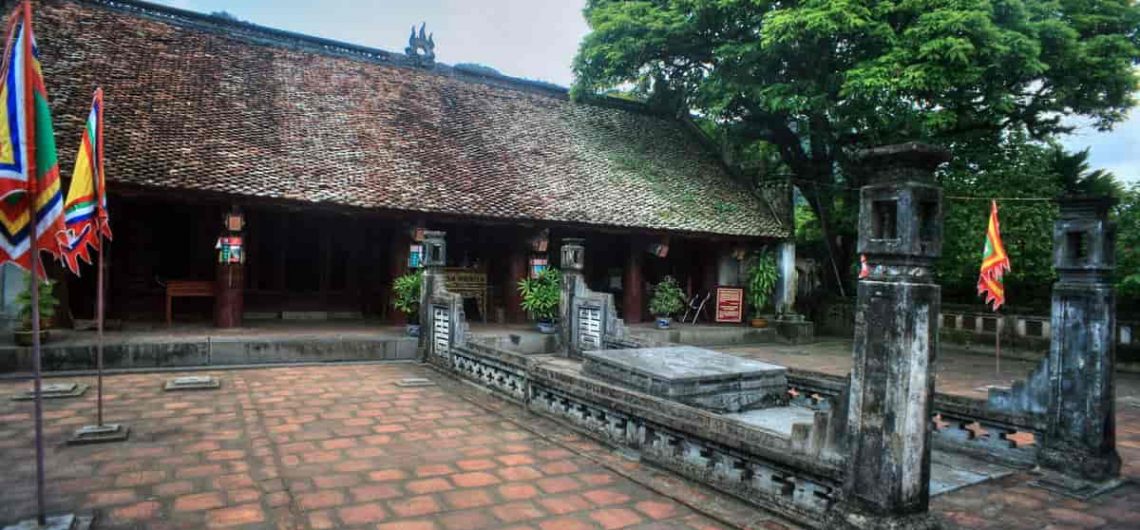
Comments